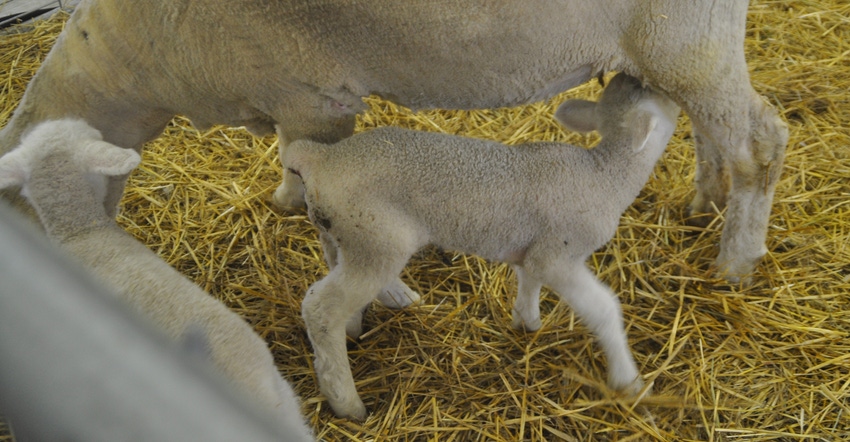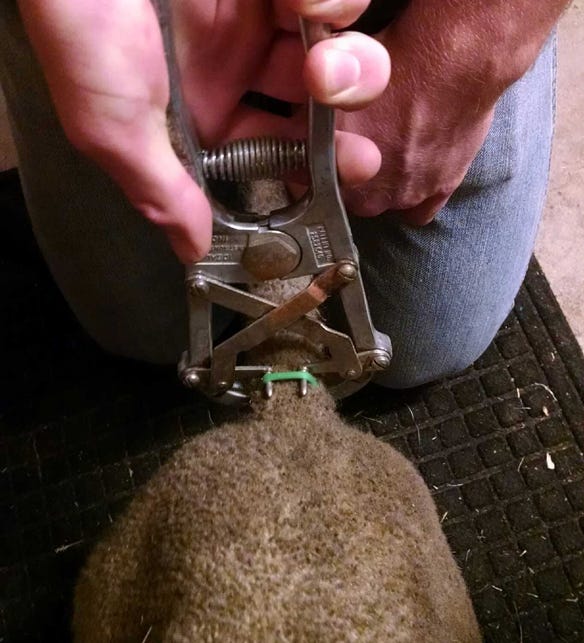February 6, 2018

A show animal is supposed to be aesthetically pleasing. After all, livestock exhibitors spend countless hours rinsing, washing, working and clipping hair in an effort to make their beloved project more appealing to the judge. And there’s considerable money spent on products, both daily care and grooming, designed to improve the animal’s appearance for the best shot at a purple ribbon.
There are many unwritten rules among livestock producers and exhibitors about how to care for these animals. No one sets out to show a steer or barrow with intentions of neglecting or harming it. That’s not what the show ring is about. There are, however, activist and producer groups who would change how livestock youth care for their beef, sheep, goat and swine projects.
For many years, tail docking has been a standard practice on club lambs. Sheep are born with long tails that are docked at around one week of age. The procedure of docking a lamb’s tail involves a rubber ring or band tied around the tail using an elastrator tool. The band cuts off blood supply to the tail, causing it to fall off in seven to 10 days and resulting in the least amount of pain possible.
The practice of tail docking is used to prevent fly strike, a painful health issue that occurs when fecal matter accumulates on the backside of the animal. Wet wool is an ideal environment for blow flies to lay eggs, which develop into maggots that feed on the sheep’s flesh. Therefore, fly strike can be a cruel and harmful problem if left unattended, and is the primary reason sheep tails are docked — to keep the animal cleaner and prevent a future harmful situation.
Many states have had had discussion regarding the length of the tail after docking in recent years. Ten years ago, breeders began cutting tails closer to the quick, making the animal more visually appealing to a show ring judge. But a problem occurs when a tail is cut too close, which can weaken sheep's rectal nerves and cause a prolapsed colon — a condition that automatically disqualifies the lamb from the show ring. Prolapse can lead to death but rapid treatment, and in many cases prevention can be effective.
 DOCKING TAILS: The Hommertzheim family from Andale, Kan., know how to tail dock their newborn lambs. All three boys show in 4-H and FFA and perform the docking procedure a few days after their lambs are born, using two bands to ensure the right length. Their dad, a livestock veterinarian, says the show industry does require a shorter dock then commercial sheep in industry.
DOCKING TAILS: The Hommertzheim family from Andale, Kan., know how to tail dock their newborn lambs. All three boys show in 4-H and FFA and perform the docking procedure a few days after their lambs are born, using two bands to ensure the right length. Their dad, a livestock veterinarian, says the show industry does require a shorter dock then commercial sheep in industry.

There is debate from animal rights activists and even some wool grower groups that a longer tail is needed to protect the sheep from weather extremes. This may not sound important for barn-raised sheep or sheep raised in mild climates, but in many production environments it is an important consideration and animal welfare issue.
Most State Fair rule books set a standard of length for tails, and rules have evolved in recent years to specifically state the animal had to have a “liftable tail,” which means a pencil or credit card must be able to lift the tail. This rule also requires x-rays on tails that appeared shorter than a three-point vertebrae length. I know of one fair in a northern state that once required x-rays on its top six sheep champions to prove whether the animals had at least three-coccygeal vertebrae present.
The goal of such specific rules on tail docking is designed to protect the health of sheep by preventing prolapse and to improve animal husbandry practices. Besides the welfare of the sheep, emphasis on such a rule actually makes proper tail docking procedures more prevalent. People are paying attention, and it makes sheep breeders and kids practice safe tail docks.
To help prevent prolapse, exhibitors should keep dust at a minimum and use a hose to keep aisles wet down in the barn. Once lambs start coughing due to dust, they are easily susceptible to prolapse.
Animal rights can be an issue at shows, and if a young person is asked by an activist why their sheep do not have tails, the response should be simple and to the point. Exhibitors should say it is a practice that provides the best possible care for the animal.
Ultimately, tail docking is a practice that causes a small amount of pain at the time of docking, but can offer relief from long-term health concerns. It has become a management practice the sheep industry adopted to create a level of health and cleanliness for the animal. The general public, or consumer, should also know that this best management practice is a positive step toward food safety.
McCurry writes from Colwich.
You May Also Like




